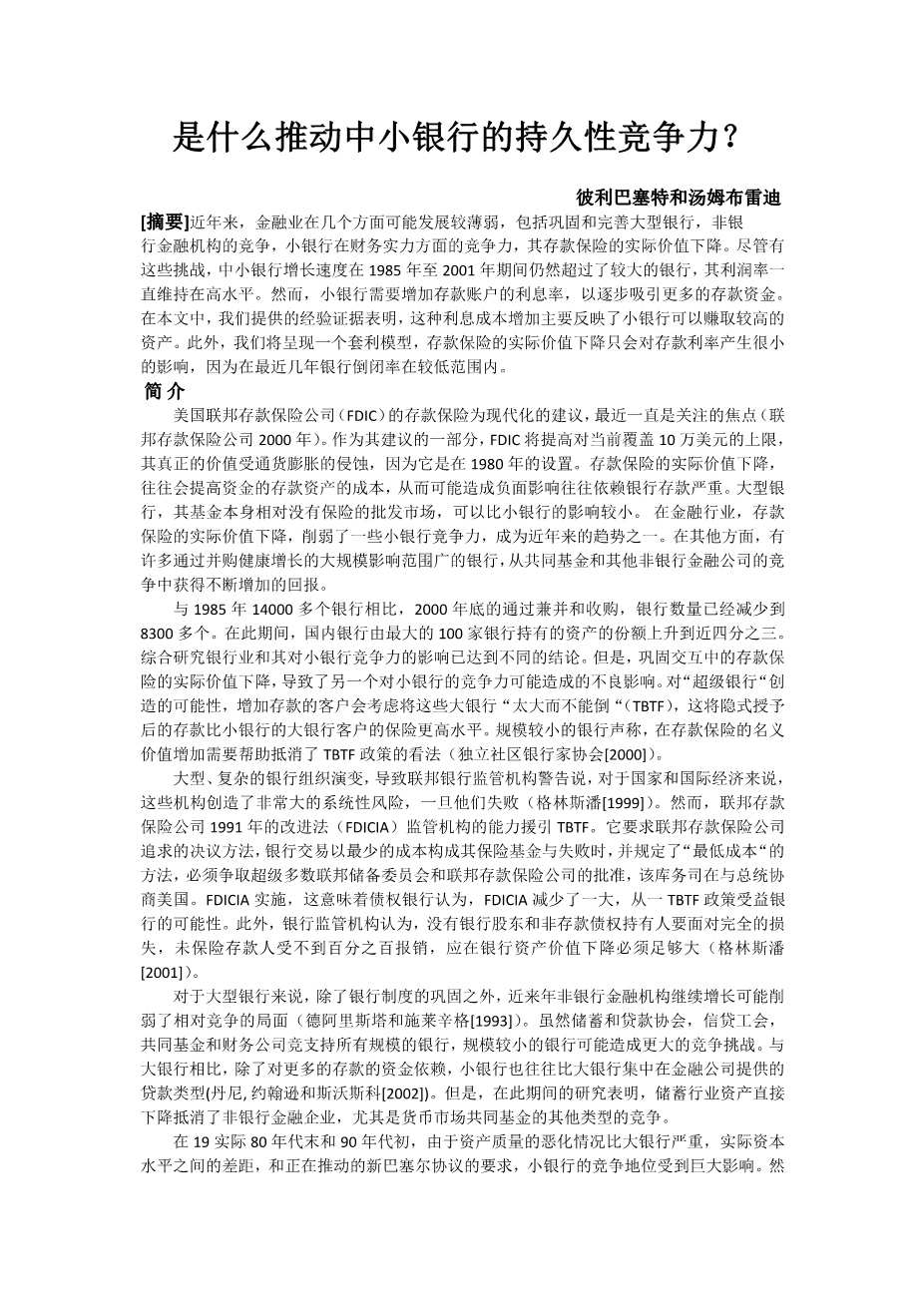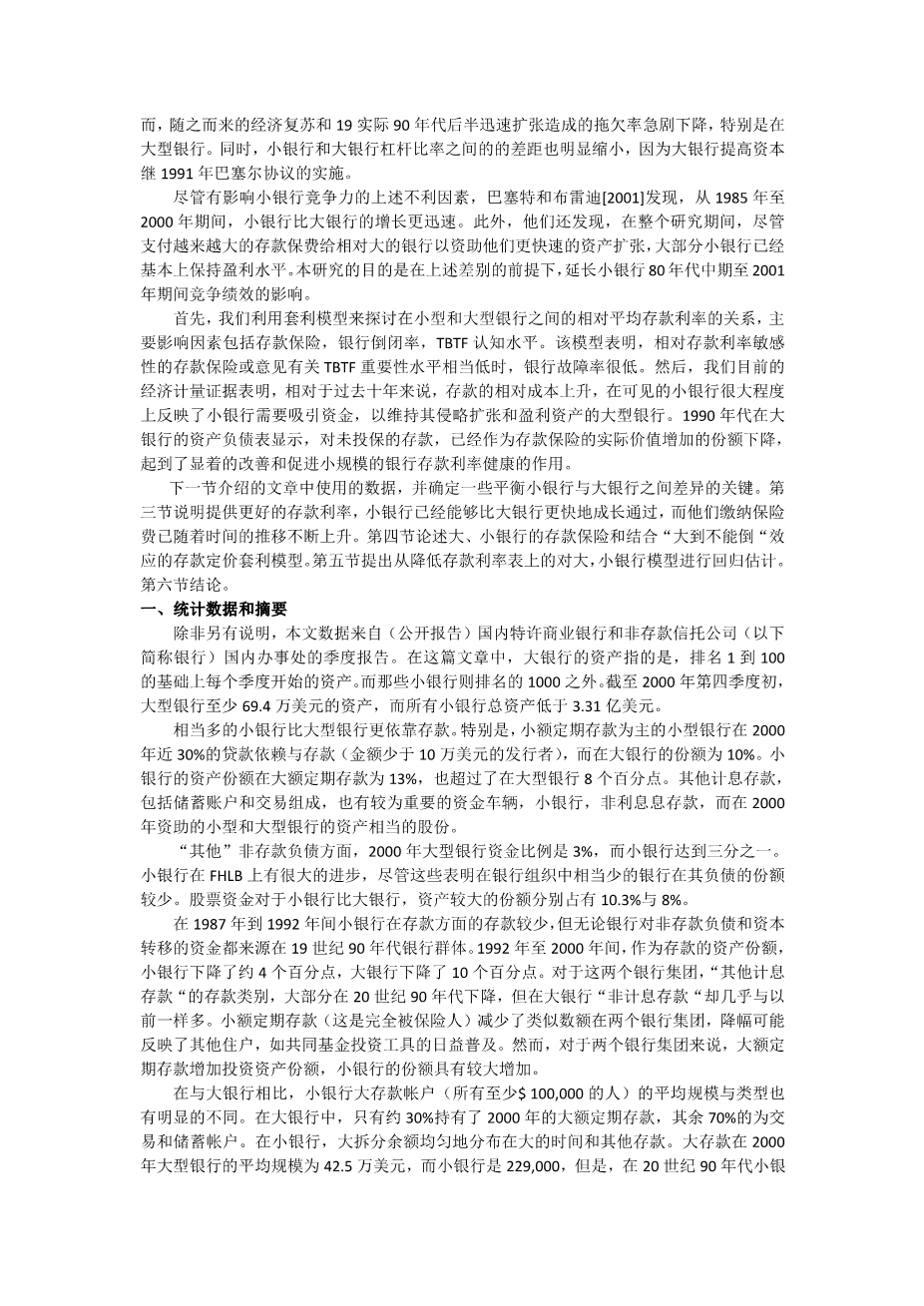Subject: What Drives the Persistent Competitiveness of Small Bank?
Citations: Finance and Economics Discussion Series 2002(5)
Author: Bill Bassett and Tom Brady
What drives the persistent competitiveness of small banks?
Abstract
Several trends in the financial industry could have weakened the competitiveness of
small banks in recent years including consolidation and improved financial strength of large banks, competition from nonbank financial firms, and a decline in the real value of deposit insurance. Despite those challenges, small banks have grown more rapidly than larger banks over the period from 1985 to 2001, and their profitability has been sustained at high levels. However, small banks have needed to increase the interest rates offered on deposit accounts in order to attract progressively more deposit funding. In this paper, we provide empirical evidence that this increased interest cost primarily reflects the higher rate of return that small banks were able to earn on their assets. Moreover, we show with an arbitrage model that the decline in the real value of deposit insurance has only a small effect on deposit rates as long as bank failure rates are in the low range of recent years.
Federal Deposit Insurance Corporations (FDIC) proposal for the modernization of deposit insurance has recently been the focus of considerable attention (FDIC 2000). As part of its proposal, the
FDIC would raise the current $100,000 ceiling on coverage in order to account for the erosion of its real value by inflation since it was set in 1980 (Chart 1). The decline in the real value of deposit insurance would tend to raise the cost of funding assets with deposits, and thus could adversely
affect banks that tend to rely heavily on deposits. Large banks, which fund themselves relatively
more in the uninsured wholesale markets, could be less affected than small banks.
The decline in the real value of deposit insurance, however, is only one of several trends in the
financial industry that could have weakened the competitiveness of small banks in recent years.
Among these other developments have been the return to health of large banks, numerous
mergers that have increased the size and scope of large banks, and the continued increase in competition from mutual funds and other nonbank financial companies.
Mergers and acquisitions have reduced the number of banks in the United States from more than 14,000 in 1985 to about 8,300 at the end of 2000, and during this time the share of domestic
banking assets held by the largest 100 banks rose from about half to almost three-fourths (Chart2). Studies of consolidation in the banking industry and of its impact on small bank competitiveness have reached differing conclusions. However, consolidation interacts with the decline in the real value of deposit insurance to create another potentially adverse impact on the competitiveness of small banks. The creation of “mega-banks” increases the possibility that depositors would
consider these larger banks to be “too big to fail” (TBTF), which would implicitly confer a greater level of deposit insurance upon large bank customers than those of small banks. Smaller banks
contend that an increase in the nominal value of deposit insurance is needed to help offset this perception of a TBTF policy (Independent Community Bankers Association [2000]).
The evolution of large, complex banking organizations has led federal bank regulators to warn
that these institutions create the potential for unusually large systemic risks to the national and
international economies should they fail (Greenspan [1999]). However, the Federal Deposit
Insurance Corporation Improvement Act of 1991 (FDICIA) circumscribed regulators’ ability to
invoke TBTF. It required that the FDIC pursue the resolution method that poses the least cost to
its insurance fund when dealing with a failed bank, and stipulated that exceptions to the
“leastcost” method must garner the approval of super majorities of both the Federal Reserve
and FDIC boards plus that of the Secretary of the Treasury in consultation with the President of
the United States. Angbazo and Saunders [1997] found the cost of funds to large banks increased after FDICIA was implemented, suggesting that bank creditors believed that FDICIA reduced the
likelihood of a large bank benefiting from a TBTF policy. Moreover, bank regulatory agencies maintain that no bank is too large for shareholders and nondeposit liability holders to face complete
loss, and for uninsured depositors to be subject to less than 100 percent reimbursement, should the decline in bank asset values be large enough (Greenspan [2001]).
In addition to the consolidation of the banking system, the continued growth of nonbank financial institutions may have weakened the competitive situation of small relative to large banks in
recent years (D'Arista and Schlesinger [1993]). Although savings and loan associations, credit
unions, mutual funds and finance companies compete with banks of all sizes, they likely pose a
greater competitive challenge to smaller banks. In addition to being more dependent on deposit
funding than the larger banks, small banks also tend to be more concentrated than large banks in the types of loans extended by finance companies (Dynan, Johnson, and Slowinski [2002]). Over the period studied, however, an outright decline in thrift industry assets offset the added
competition from other types of nonbank financial companies, particularly money market mutual funds.
In the late 1980s and early 1990s, the competitive position of small banks likely was boosted as a
剩余内容已隐藏,支付完成后下载完整资料


英语译文共 4 页,剩余内容已隐藏,支付完成后下载完整资料
资料编号:[485778],资料为PDF文档或Word文档,PDF文档可免费转换为Word
以上是毕业论文外文翻译,课题毕业论文、任务书、文献综述、开题报告、程序设计、图纸设计等资料可联系客服协助查找。


